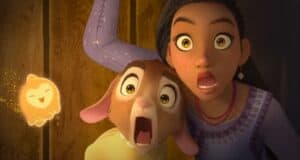
Disney cartoons are no stranger to controversy. Whether we are talking about Song of the South, LGBTQ characters, or stereotypes depicted in older classics such as Dumbo or Peter Pan. When it comes to problematic characters and images, there seems to be no shortage in the Disney vault.
But among the many feature films that have sparked debates, boycotts, and banning, there is another class of Disney works considered by some to be just as controversial.
Related: The Rachel Zegler and Disney’s ‘Snow White’ Controversy: How Did We Get Here?
The WWII Disney Shorts
During World War II, The Walt Disney Company played a crucial role in contributing to the war effort through a series of animated shorts. Walt Disney himself was dedicated to using the power of animation for both entertainment and propaganda to support the Allied forces.
During this period, Disney produced several other war-related shorts featuring classic characters such as Donald Duck. These cartoons were used to inform, inspire, and lift audiences’ spirits during a challenging period in global history.
Related: Walt Disney and Lucille Ball’s Secret Connection Is Revealed
Many of them used humor and satire to garner support for the war effort and encourage unity and patriotism.
In addition, Disney also contributed to military training with films like Four Methods of Flush Riveting (1941) and Stop That Tank! (1942), which provided instructional content for wartime industries. These shorts demonstrated Disney’s versatility in using animation for entertainment and as an educational and propaganda tool.
The Controversial “Der Fuehrer’s Face” (1943)
One of the most famous wartime Disney shorts is Der Fuehrer’s Face, which starred Donald Duck. Released in 1943 during World War II, the cartoon is a satirical take on life under the Nazi regime.
The story begins with Donald Duck experiencing a surreal nightmare in which he finds himself living in a nightmarish version of Nazi Germany. The cartoon cleverly uses exaggeration and parody to depict life’s oppressive and absurd aspects under totalitarian rule.
Related: Disney Actress Fired After Controversial Israel/Palestine Posts
Throughout the short, Donald is forced to work in a munitions factory, performing repetitive and dehumanizing tasks.
As the cartoon progresses, Donald’s nightmare intensifies. The viewer is taken on a rollercoaster of comical and surreal scenarios that become more and more absurd. The level of humor is on par with many cartoons of that decade, including Looney Tunes and Tom and Jerry.
Related: Beloved Children’s Show Incites Controversy After Potentially-Harmful Scene
The animation of the Disney short cleverly blends humor with poignant moments.
In addition, the short contains the title song, “Der Fuehrer’s Face.” This song was composed by Oliver Wallace and serves as both a musical centerpiece and a satirical commentary on the Nazi propaganda machine.
In the end, the nightmare is revealed to be a dream, and Donald wakes up to find himself in the United States. The cartoon concludes with Donald hugging a Statue of Liberty paperweight and expressing his love for living in the United States of America.
The film also won an Academy Award for Best Animated Short Film in 1943.
Banned in Russia
The heavy dose of satire used in the short often causes many to judge it simply based on still images. To a casual observer, you can easily spot images of Donald in Nazi uniform, hundreds of swastikas, jokes about being the master race, and many “Heil Hitler!” salutes.
When taken out of context (as most things are nowadays), it’s easy to see how people misinterpret the intention of the short and be offended.
Enter…Russia and the Russian Ministry of Justice’s Federal List of Extremist Materials.
In 2010, there was a case that accused a local resident of “inciting hatred and enmity” for uploading “extremist” material—including the Disney short—to the internet.
The individual received a six-month suspended sentence. However, the Donald Duck cartoon was added to the Russian Ministry of Justice’s Federal List of Extremist Materials.
As such, that meant the cartoon was illegal to produce, store, or distribute in Russia.
Related: Remember the Vladimir Putin Audio Animatronic at Disney World?
The Russian list of banned materials was established in 2002 and contains over 3,700 items. It is mainly comprised of material that is religious, critical of the Russian government, and Nazi propaganda. And due to the case in 2010, the Donald Duck cartoon was part of the latter category.
This satirical approach to the film appeared to be lost on the Russian court.
After discovering the Donald Duck short had been added to the extremist materials list, RT explains, the case’s prosecutors “filed a cassation [sic] with the regional court explaining that the video is a classic Walt Disney cartoon made within the framework of an anti-Nazi propaganda campaign.”
Related: Twitter Places Disney Ads Next to Neo-Nazi Propaganda
It was further explained that the film wasn’t praising Nazism. It was, in fact, mocking the ideology.
The court ended up agreeing with this interpretation, and in 2016, the film was eventually removed from the list.
The Short’s Legacy
Although the cartoon isn’t banned in America (at least not currently…), it maintains a mixed legacy of sorts. As stated earlier, it is an Oscar-winning film and has been praised for its music.
In fact, the short’s song was released as a standalone single and was a major radio hit, according to Time magazine.
Furthermore, in 1994, it was voted Number 22 of “the 50 Greatest Cartoons” of all time by members of the animation field. It also goes by the alternative titles “A Nightmare in Nutziland” or “Donald Duck in Nutziland.”
Related: Donald Duck Has Entered the Republican Presidential Race
However, it is a film that Disney has tried to keep out of the public light. Although it does not promote Nazism, its safe to assume the company is not too happy with the problematic images of Donald Duck. They would want to avoid images of him with a swastika on his arm and saluting Hitler.
As such, Disney kept the film out of general circulation. Its first home release came in 2004 with the release of the third wave of the Walt Disney Treasures DVD sets. However, nowadays, it can be found online relatively quickly.












